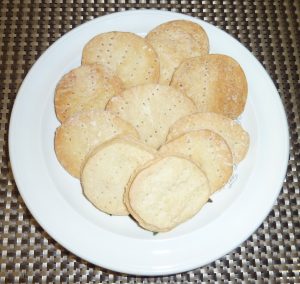Trading Fort Foods
Trading Forts such as those with HBC links had to provide food for employees. traders, sea captains, drovers, packers, sappers and Home Guard / Metis who were essential to the fur trading business.. References to food usually includes typical foods, from ships biscuits to salmon.
Fort Okanagan is described in Ross Cox’s book Adventures on the Columbia. In the 11th Report of Okanagan History, Frank Haskins included excerpts from this book. Although it has gone out of print, the book is now available on line as a free ebook at https://books.google.ca.)
Cox wrote about his experiences during 1811 to 1816 at Fort Okanagan where he was a clerk for The Pacific Fur Company and became a clerk for the North West Company when it bought Pacific Fur in 1813. Fort Okanagan was located at the confluence of the Columbia and Okanagan rivers in present day Washington State, long before British Columbia came into existence.
In a letter from Trader McGillivray included in Cox’s book, it appears that the food eaten at the Fort was often meat: “I have hitherto principally subsisted on horseflesh. I cannot say it agrees with me…. I have had plenty of pork, rice, arrow-root, flour, taro-root, tea, coffee; no sugar…. And, here I am, with a shivering guard of poor islanders (Sandwich or Hawaiian Island workers), buried in snow, sipping molasses, smoking tobacco, and masticating horse-flesh!” (Haskins, 1936, p. 106).
Eating was neither glamorous nor well-balanced as evidenced from Cox’s writing. There is mention of a kitchen garden at Fort Okanagan in 1815 where potatoes, melons and cucumbers were grown. In 1816, Cox wrote: “Our living consisted of salmon, horse, wild fowl, grouse, and small deer with tea and coffee; but without the usual adjuncts of milk, bread, or butter” (Haskins, 1936, p. 108). Cox further wrote: “Tea and tobacco were my only luxuries…. Dried salmon was our principal article of food….” (Haskins, 1936, p. 109).
Locke (1993) points out that the Hudson Bay Company forts initially relied on supply ships from England a couple of times each year to deliver provisions. After the Hudson Bay and North West Companies merged in 1820, George Simpson, governor of the Hudson Bay Company required traders to economize by obtaining all their provisions from the land on which they lived. Archibald McDonald wrote: “ Dried salmon is the staff of life, without it this post (Fort Kamloops) could not have been maintained” (Locke, 1993, p. 15). Dried salmon was light in weight, packed and travelled easily and could keep indefinitely. However, since the diet consisted almost entirely of dried salmon, the men who depended on it soon complained loudly and long. Salmon was also an unreliable supply because while there were years of plenty there were also years of starvation among First Nations and traders. By the 1850s, salted horse meat had almost completely replaced salmon as a staple food and the diet was supplemented by bear, deer, elk, caribou, ducks, rabbits and dogs.
Reliance on local food sources encouraged the Forts to produce their own food and engage in food trade with the First Nations and other forts. Fort Kamloops began to grow potatoes and wheat. In 1841, the Christmas gift to men at the Fort included: 1 quart flour, 1 quart Indian corn, 3 pounds horse meat, 1 pint wine and 1 pound grease.
Different forts had different resources and Fort Langley, established in 1827 quickly moved to supply the West Coast forts with salt salmon and exported as much as 400 barrels of salt salmon to the Hawaiian Islands as early as 1840 (Reid, 1937). Fort Langley began farming and contracted in 1834 to supply the Russian American Company with wheat flour, peas, barley, beef, butter and ham (Reid, 1937).
Jean Barman wrote about family life at Fort Langley and described how Christmas was a time for the wives to mix with the men and all classes of workers. She noted that the women were invited to the big hall and asked to bring their baskets with them so the baskets could be filled with cookies, cranberries, blueberry jam and ship’s biscuits and they were served two or three shots of celebratory wine.
Barman’s mention of Ship’s Biscuits encouraged me to look further at what these were and to try an old recipe. I expected them to be almost inedible but fresh from the oven, they were delicious and much like soda crackers we know today. It seems that Ship’s Biscuits originated around the 1500s when foods with a long shelf life were needed for long sea voyages. They are also known as “hard tack.”
Ship’s Biscuits
Original ingredients: 1 pound flour
1 cup water
½ tablespoon sea salt
Optional ingredients: 2 ounces butter
1 cup milk instead of water
Measure flour and salt into a bowl.
Warm the water or milk and butter if using.
Add liquid ingredients to dry and mix well.
Knead the dough until it holds together, roll it thin, and cut like biscuits.
Place biscuits on a baking pan and prick all over.
Bake at 350 degrees for 30 to 40 minutes until golden brown.
Be sure the biscuits are dry throughout so they will not mold or spoil.
Source: cookit.e2bn.org (History Cookbook)
References:
Barman, J. (1999). Family Life at Fort Langley. British Columbia Historical News, 32(4), 16-23.
Cox, R (1832). Adventures on the Columbia River. New York: J. & J. Harper. Accessed at https://books.google.ca/books?id=Li8TAAAAYAAJ&pg=PA160&source=gbs_toc_r&cad=3#v=onepage&q&f=false
Haskins, F. (1936). Ross Cox on the “Oakinagan”. Okanagan History 11th Report of the Okanagan Historical Society, pp. 105 – 110.
Locke, J. (1993). No Salmon, No Furs: The Provisioning of Fort Kamloops, 1841-49. British Columbia History Magazine, 26 (2), 14-18.
Reid, R.L. (1937) Early Days at Old Fort Langley. British Columbia Historical Quarterly, 1(2), 74-86.

